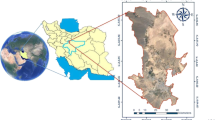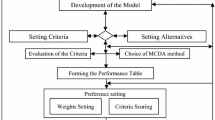Abstract
Desertification is the result of natural and anthropogenic processes, leading to degradation or loss of the land’s productivity and complexity. To assess the desertification status, integrated set of indicators must be identified. Indicators must provide synthetic information on threshold levels, status and evolution of relevant physical, chemical, biological and anthropogenic processes. Multi-criteria decision-making (MCDM) is a collection of methodologies to compare, select, or rank multiple alternatives that involve incommensurate attributes. Technique for order preference by similarity to ideal solution (TOPSIS) method is a multiple criteria method to identify solutions from a finite set. TOPSIS is an algorithm for determining the most preferable choices among the possible indicators that can be developed. The aim of this paper is to introduce TOPSIS as a decision-making method for the selection and integration of desertification indicators. The simulation case study presented here is related to the selection of the best set of indicators to monitor land degradation by remote sensing in three different countries (Brazil, Mozambique and Portugal), within the framework defined by the DesertWatch Extension project.

Similar content being viewed by others
Notes
Environmental Sensitive Areas (in this method, different types of ESAs to desertification can be analyzed in terms of various parameters such as landforms, soil, geology, vegetation, climate and human actions. Each of these parameters is grouped into various uniform classes and a weighting factor is assigned to each class. Then four layers are evaluated: soil quality, climate quality, vegetation quality and management quality. For more information, see Kosmas et al. 1999).
Technique for Order Preference by Similarity to Ideal Solution (Hwang and Yoon, 1981).
NADIR point is a geometric allegory for distance of preferred indicators from desirable and undesirable solutions which has shortest distance from positive solution and farthest distance from negative solution.
References
Armas R, Caetano M, Carrão H, Soares A, Pereira MJ, Gutierrez A, Rocha A, Pace G, Zucca C, del Barrio G, Paganini M (2010) Earth observation from space to support the unccd:the Desertwatch Extension project. Paper presented to the Living Planet Symposium, Bergen (Norway), July 1, 2010
Brans JP, Mareschal B, Vincke Ph (1984) PROMETHEE: A new family of outranking methods in multi criteria analysis. Journal of Operational Research. 84:477–490
Gentile AR (1998) From national monitoring to European reporting: the EEA framework for policy relevant environmental indicators. In: Enne G, d’Angelo M, Zanolla C (eds), Proceedings of the International Seminar on Indicators for Assessing Desertification in the Mediterranean, Porto Torres (Italy) pp 18–20, September, 16-26, 1998
Hwang CL, Yoon K (1981) Multiple attributes decision making methods and applications. Springer, New York
Kosmas C, Kirkby M, Geeson N (1999) The MEDALUS project Mediterranean desertification and land use; Manual on key indicators of desertification and mapping environmentally sensitive areas to desertification. European Commission, Brussels
Niemeijer D, de Groot RS (2008) Framing environmental indicators: moving from causal chains to causal networks. Environ Dev Sustain 10:89–106
Olson DL (2001) Comparison of three multi criteria methods to predict know outcomes. Eur J Oper Res 130(3):576–587
Olson DL (2004) Comparison of weights in TOPSIS models. Mathematical and Computer Modeling. 40:721–727
Opricovic S (1998) Multi criteria Optimization of Civil Engineering Systems. Faculty of Civil Engineering, Belgrade
Opricovic S, Tzeng GH (2004) Compromise solution by MCDM methods: A comparative analysis of VIKOR and TOPSIS. Eur J Oper Res 156(2):445–455
Reed MS, Dougill AJ, Baker TR (2008) Participatory indicator development: what can ecologists and local communities learn from each other? Ecol Appl 18:1253–1269
Roy B (1990) The outranking approach and the foundations of ELECTRE methods. In: Bana e Costa CA (ed) Readings in multiple criteria decision aid. Springer, Berlin, pp 155–183
Saaty TL (1980) The analytic hierarchy process: planning, priority setting, resource allocation. McGraw-Hill, New York
Shen Q, Jensen R (2007) Rough Sets. Their Extensions and Applications, International Journal of Automation and Computing 4(3):217–228
Sommer S, Zucca C, Grainger A, Cherlet M, Zougmore R, Sokona Y, Hill J, Della Peruta R, Roehrig J, Wang G (2011) Application of indicator systems for monitoring and assessment of desertification from national to global scales. Land Degrad Dev 22:184–197
Thomas DSG (1997) Science and desertification debate. J Arid Environ 37:599–608
Triantaphyllou E, Lin C (1996) Development and Evaluation of Five Fuzzy Multi-Attribute Decision-Making Methods. Approximate Reasoning 14(4):281–310
UNCCD (1994) United Nations convention to combat desertification in countries experiencing serious drought and/or desertification, particularly in Africa. A/AC.241/27, Paris
Zeleny M (1982) Multiple Criteria Decision Making. McGraw-Hill, New York
Zucca C, Previtali F, Enne G (2004) Ongoing research and concentration activities on desertification in Northern Mediterranean Countries (UNCCD Annex IV). In: Zdruli P, Steduto P, Kapur S, Akca E (eds), Proceedings of the International Seminar “Ecosystem-based assessment of soil degradation to facilitate land users’ and land owners’ prompt actions”, Adana, Turkey, 2–7 June 2003. MEDCOASTLAND publication 1. IAM Bari, Italy. pp 315–327
Zucca C, Della Peruta R, Salvia R, Cherlet M, Sommer S (2010) Evaluation and integration of baseline indicators for assessing and monitoring desertification. European Communities, EUR Report in press, ISSN 1018-5593, Luxembourg, Office for Official Publications of the European Communities
Zucca C, Della Peruta R, Salvia R, Sommer S, Cherlet M (2012) Towards a World Desertification Atlas. Relating and selecting indicators and datasets to represent complex issues. Ecol Ind 15:157–170
Acknowledgments
The data used were kindly provided by the DesertWatch Extension project, a project funded by the European Space Agency (ESA) and coordinated by Advanced Computer System (ACS Spa). Data have been collected by the implementing Consortium lead by Critical Software SA.
Authors would like to thank Prof. S. Madrau of the Sassari University for his assistance in the preparation of this paper.
Author information
Authors and Affiliations
Corresponding author
Rights and permissions
About this article
Cite this article
Sepehr, A., Zucca, C. Ranking desertification indicators using TOPSIS algorithm. Nat Hazards 62, 1137–1153 (2012). https://doi.org/10.1007/s11069-012-0139-z
Received:
Accepted:
Published:
Issue Date:
DOI: https://doi.org/10.1007/s11069-012-0139-z




